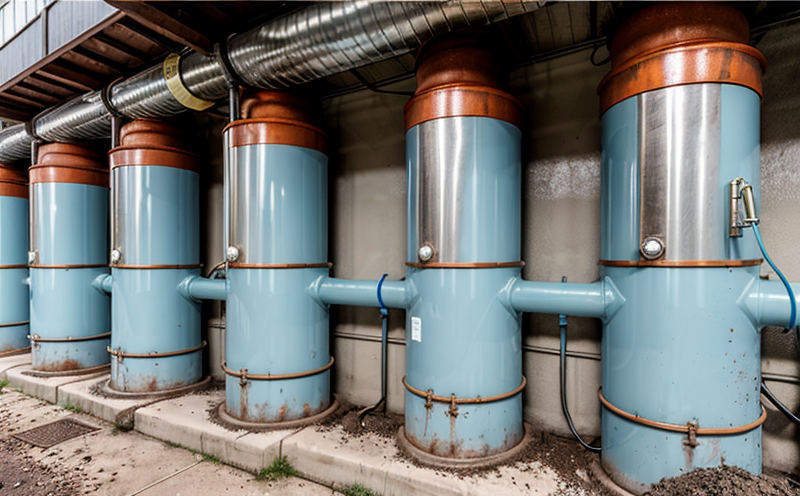ASTM G223 Deposit Porosity Analysis Test in Water Systems
The ASTM G223 test is a critical tool used to assess the porosity of deposits or scale formed within water systems. This test provides essential data for quality managers, compliance officers, R&D engineers, and procurement teams to ensure that their facilities meet the highest standards of safety and efficiency.
Porosity in water systems can lead to significant operational challenges such as reduced flow rates, increased energy consumption, and potential system failures. ASTM G223 helps identify these issues early on by examining the physical properties of deposits, including their composition, thickness, and porosity level. This information is crucial for maintaining optimal performance and extending the life of water treatment equipment.
The ASTM G223 procedure involves subjecting a sample of scale or deposit to specific conditions that simulate real-world operating environments. The test aims to quantify how porous the material is under these conditions, which can help predict its behavior in different settings. By understanding the porosity characteristics, engineers and scientists can make informed decisions about the design and maintenance of water systems.
The testing process typically follows a series of steps designed to replicate actual field conditions as closely as possible. Samples are carefully prepared according to ASTM G223 guidelines before undergoing mechanical or thermal treatments intended to stress the deposit structure further. The resulting data provides detailed insights into not only the current state but also potential future issues related to scaling and corrosion.
One of the key aspects of this test is its ability to reveal whether a given scale type has high porosity, which could indicate it might be more prone to microbial growth or easier for fouling agents to adhere. Such knowledge allows facility operators to take proactive measures against these problems before they become detrimental to operations.
Another important outcome of ASTM G223 is the assessment of a deposit’s resistance to erosion caused by fluid flow. High porosity materials tend to erode more quickly than dense ones, affecting both performance and longevity of pipe systems. Understanding this characteristic helps in selecting appropriate materials for new constructions or retrofitting existing infrastructure.
For those involved in quality assurance programs or seeking compliance with international standards like ISO 9001:2015, ASTM G223 offers a reliable method to demonstrate adherence to best practices regarding water treatment and management. Its wide acceptance across various industries ensures that results obtained are universally applicable.
The importance of accurate testing cannot be overstated when dealing with complex systems where even minor discrepancies can have major implications on overall efficiency. With ASTM G223, laboratories like ours provide precise measurements backed by rigorous methodology ensuring reliability and accuracy.
Applied Standards
The ASTM G223 test is specifically designed to comply with the requirements set forth in American Society for Testing and Materials (ASTM) standard E1576-08. This standard provides detailed instructions on how to conduct porosity tests on deposits or scales found within water systems.
- ASTM G223 focuses primarily on determining the percentage of void space present in solid materials derived from water treatment processes.
- The procedure covers both quantitative and qualitative evaluations, allowing for comprehensive analysis of deposit samples.
To ensure consistency across different laboratories performing ASTM G223 tests, strict adherence to all specified procedures is mandatory. This includes precise sample preparation methods, controlled environmental conditions during testing, and standardized reporting formats.
By following these guidelines, users can rest assured that their results are comparable with those generated by other reputable institutions worldwide. The use of established standards such as ASTM G223 not only enhances credibility but also facilitates smoother collaboration between various stakeholders involved in water system management.
Benefits
The ASTM G223 Deposit Porosity Analysis Test offers numerous benefits that are particularly valuable for industries reliant on clean and efficient water systems. Here’s a closer look at some key advantages:
- Early Detection of Issues: By identifying deposit porosity early, facilities can address potential problems before they escalate into costly repairs or disruptions in service.
- Enhanced Efficiency: Reduced scaling and erosion lead to better flow rates and lower energy consumption, contributing significantly to operational efficiency.
- Predictive Maintenance: Understanding deposit characteristics allows for more accurate predictions about when maintenance will be needed, reducing unplanned downtime.
- Better Decision Making: With detailed information on deposit properties, managers can make informed choices regarding material selection and system design.
In addition to these direct benefits, compliance with standards like ASTM G223 also enhances a company’s reputation among customers, suppliers, and regulatory bodies. It demonstrates a commitment to excellence in water management practices, which is increasingly important as environmental regulations become more stringent.
For research and development teams, the ability to consistently measure deposit properties through reliable tests such as ASTM G223 provides valuable input for innovation efforts aimed at improving water treatment technologies.
International Acceptance and Recognition
- Australia: The Australian Standard AS 1697.2:2018 on Water Quality – Determination of Particulate Matter in Drinking Water includes references to ASTM G223 for assessing deposit characteristics.
- Canada: Canadian standards such as WSIB (Water Services, Infrastructure and Building) often align with ASTM practices including those related to water treatment processes.
- European Union: Various EU directives concerning drinking water quality reference methods similar to ASTM G223 for evaluating deposit formation in water systems.
- India: The Bureau of Indian Standards (BIS) has incorporated ASTM G223 into its guidelines for testing water treatment equipment and materials used in such applications.
The widespread adoption of ASTM G223 across multiple countries underscores its importance in the global water management industry. Whether it's for compliance purposes or simply to ensure best practices, this test remains a cornerstone of modern water quality assessment protocols worldwide.





